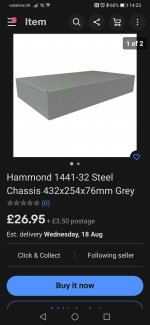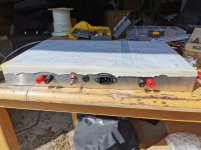Hammond steel chassis are good but expect to pay $$ for fedex International shipping to put a dent in it.
My next amp - I will simply use a thick steel/aluminimum plate. Then simply fit the components to that directly.. followed by mounting by the four corners into a chassis.
My next amp - I will simply use a thick steel/aluminimum plate. Then simply fit the components to that directly.. followed by mounting by the four corners into a chassis.
Does shielded cable works OK to suppress noise if I use longer IP cables?
Hi Jose,
Shielded cables are always a good idea when you have to run them past any other items under the chassis. And never run audio signal cables parallel to power wires. Run them across the top of them if you have to cross them over, but don't make the mistake of tidying all the cables together in a nice run along the edge of the chassis
2 Tricks for running audio signal cables that really helps
1) Twist the wires together so the twisting interrupts any magnetic currents around the wires
2) Take the twisted pair and run them through a copper mesh like the inner shielding from an old coax cable. Ground either end of the shielding to the chassis as close to the terminated ends of the wire, or near to the components as possible.
And YES what is that family of tubes on the left that looks like Daleks?
So good to hear a Doctor Who reference again
I've recently started a new amp and am using a Grundy roasting tin as the chassis, they can be bought new in the UK for about £30. They are solid ali, thickness about 2.5mm.
.
Andy.
Those are really nice because the sides go back to 90 degrees and the corner radius is a tighter bend. Unfortunately all roasting pans in the US tend to have angled sides, long radius bends, weird non stick coatings, etc. I'm tempted to see if they can ship one of these to the states. Great price, thanks.
About the input, this is something I'm still trying to decide. If I use a dual pot, it means cabling from the input tubes to the pot, which will be located right in the middle of the front panel, then it will make sense to also have the RCA sockets next to it.
If you "copy" the EICO HF87/HF89 model, a single 12AX7/ECC83 serves as the voltage amplifier for both channels. A stereo, ganged, control near a centrally located bottle makes considerable sense to me.
...
I'm looking to build a class AB1 stereo amp, based on 6L6 (6P3S-E) valves, been working on the component layout, and it would be great if you can comment on it. No need to be gentle, I can take punishment 😀
...
Sorry to go back quite a few posts, but I was wondering if the gap to the front edge of your chassis is a bit tight with the placement of those driver tubes? It looks like there is less than 1cm to the inside of the chassis, which could be a bit tight to work in, and will put the hot tubes very close to the chassis edge.
This is code for " super deep bass serving" : )The website fails to mention which one is for tube amplifiers though.
85mm - deep for food service
The Dalek tooobs are 2C34, 6BL7, DET20/2C22 and HY615 all triodes.
Re single dual gang or separate pots, dual gang pots often have abysmal tracking, two separate pots save a balance control, it's swings an roundabouts. More pots = more knobs, decent ali knobs can be expensive. Building amps, lots to think about, forget chess, DIY amp builders have to think 50 moves ahead whilst juggling chainsaws : )
Sorry to go back quite a few posts, but I was wondering if the gap to the front edge of your chassis is a bit tight with the placement of those driver tubes? It looks like there is less than 1cm to the inside of the chassis, which could be a bit tight to work in, and will put the hot tubes very close to the chassis edge.
That has been my concern too, I decided that it should be OK even if there is not a lot of space. But now there are suggestions about using a 12AX7 shared as the input stage, that could mean just moving the socket to the centre. I was also looking at putting the 4 valves in a square arrangement, with the input valve on the top left corner, further away from the power circuits.
This is code for " super deep bass serving" : )
The Dalek tooobs are 2C34, 6BL7, DET20/2C22 and HY615 all triodes.
Re single dual gang or separate pots, dual gang pots often have abysmal tracking, two separate pots save a balance control, it's swings an roundabouts. More pots = more knobs, decent ali knobs can be expensive. Building amps, lots to think about, forget chess, DIY amp builders have to think 50 moves ahead whilst juggling chainsaws : )
I would say "...whilst juggling running chainsaws" 🙂
Decisions, decisions, decisions... It was easier in Cuba, you just used what you could find, which was always restricted to whatever was used in old TVs and radios. Who cares about harmonics and hum 🙂
Hi Jose,
Shielded cables are always a good idea when you have to run them past any other items under the chassis. And never run audio signal cables parallel to power wires. Run them across the top of them if you have to cross them over, but don't make the mistake of tidying all the cables together in a nice run along the edge of the chassis
2 Tricks for running audio signal cables that really helps
1) Twist the wires together so the twisting interrupts any magnetic currents around the wires
2) Take the twisted pair and run them through a copper mesh like the inner shielding from an old coax cable. Ground either end of the shielding to the chassis as close to the terminated ends of the wire, or near to the components as possible.
And YES what is that family of tubes on the left that looks like Daleks?
So good to hear a Doctor Who reference again
I understand the use of twisted pair for wiring that carries AC, or differential input stages. But for a regular asymmetric input, we won't have the common mode rejection effect, right? Why not just an old style shielded wire or a coax cable?
If you "copy" the EICO HF87/HF89 model, a single 12AX7/ECC83 serves as the voltage amplifier for both channels. A stereo, ganged, control near a centrally located bottle makes considerable sense to me.
I was looking into that option, but wanted to have a bit more freedom in the input stage in case I want to do something else later. A spare triode can be a useful thing 🙂
Downloaded the EICO HF87/89 manuals, try getting something as detailed as that for a modern piece of hardware! It will help me a lot with the wiring.
I understand the use of twisted pair for wiring that carries AC, or differential input stages. But for a regular asymmetric input, we won't have the common mode rejection effect, right? Why not just an old style shielded wire or a coax cable?
Yes Sorry Jose,
I meant twisted pair for AC lines and Shielded wires for signal lines.
But looks like your already on top of it.
One thing I have seen A LOT in many electronics projects is people making twisted pairs with the same coloured wire. I think you already know not to do that though.
It just causes headaches later on when tracing issues
No need to apologise, I was just asking a question, I do not pretend for one moment to be an expert 😀
Thank you and everyone in this thread for the useful advice! Still waiting for a couple of components before I start drilling.
BTW, the "Heater Wiring" sticky thread is phenomenal!
Thank you and everyone in this thread for the useful advice! Still waiting for a couple of components before I start drilling.
BTW, the "Heater Wiring" sticky thread is phenomenal!
- Home
- Amplifiers
- Tubes / Valves
- Newbie looking for advice on stereo amp layout


